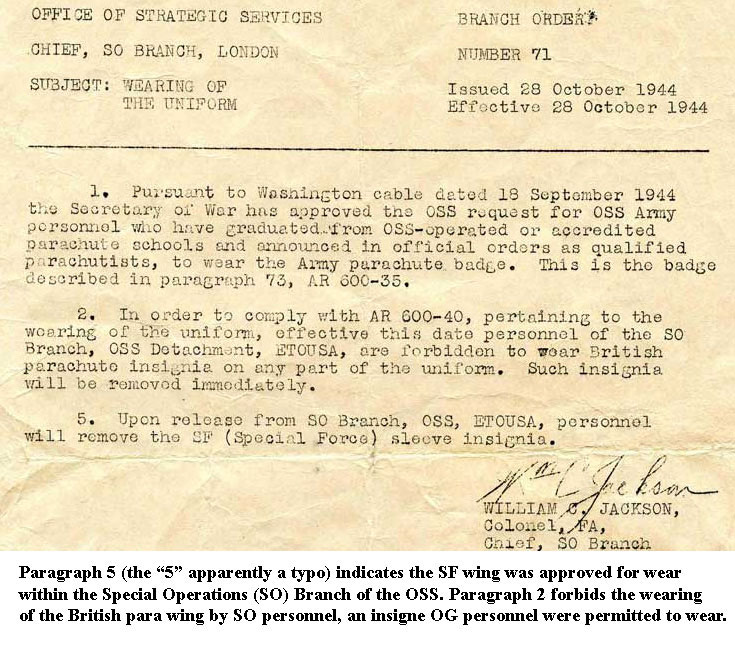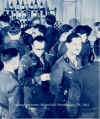|
insigne.org |
The SF Wing by Les Hughes © 1987 by author
|
|
|
|
Although one of the more sought-after cloth insignia of the WWII period, the history of the Special Force (SF) wing remains obscure to many collectors.1 (Note that the singular form, Special Force, is correct.) This insigne originated with the joint OSS/SOE Jedburgh teams.2 As was the case with many insignia, the design of the SF wing emerged from a contest, in this case one held among the Jeds at Milton Hall, Peterborough, which served as their Headquarters. The winning design, upon which the SF wing is based, was submitted by one of the British Jeds, Captain V. A. Gough.3 After its creation, the SF wing spread to other units operating under the control of Special Force Headquarters (SFHQ), most notably to members of the OSS’s Operational Groups (OGs) based in England, and to a few uniformed SOE teams operating in France. And an order of the Polish Commander-in-Chief and the Ministry of National Defense dated 19 September 1944 granted the right to wear the SF wing to all soldiers of the airborne-trained Independent Grenadiers Company and Polish Operational Branch of C-in-C HQ who had completed training and were assigned to combat. Additionally, after the completion of Operation JEDBURGH, a Jedburgh training program (designated Military Establishment 94) was established by the British in Horana, Ceylon, for operations under the Southeast Asia Command, and a number of British Jeds, and perhaps the SF wing, as well, were incorporated into that program. (The SF wing can also be found on the uniforms of some Canadian members of Force 136. Evidence suggests these SF wings were privately purchased in England.)4 That the SF wing enjoyed a measure of official recognition within OSS is reflected by Order 71, issued by the Chief of OSS’s Special Operations Branch, London, on 28 October 1944. The third paragraph of this order states: “Upon release from the SO Branch, OSS, ETOUSA, personnel will remove the SF (Special Force) sleeve insignia.” Order 71 also cites an Army Regulation in forbidding the wearing of the British parachute insignia by SO personnel. This did not apply to OG personnel. On 8 August 1944, letters were sent to LTC Obolensky, head of the OGs in ETOUSA, that LTG Browning, commander of Britain’s 1st Airborne Corps, had approved the wearing of the British parachute wing by OG personnel who had qualified in the same manner as British personnel. Wearing of the British para wing by the OGs was restricted to the right sleeve. And while Order 71 requires SO personnel to remove the SF wing when leaving ETOUSA, photographs of OG personnel taken in the States upon their return from ETOUSA show the SF wings still on their uniforms. Upon completion of their operations in the ETO, some of the OSS and SOE personnel who wore the SF wing were sent, respectively, to OSS units in the CBI Theater and to Force 136, and by this mechanism the SF wing was carried (in spite of Order 71) far from its origin. (A wing of the style found among veterans of Force 136 is illustrated below.) Today, one encounters versions of this insigne attributed to just about every theater of operations, but the fact is that the wing was worn almost exclusively by OSS and SOE troops operating in the ETO (i.e., primarily in France) or who previously had operated there. Furthermore, its use was more extensive among OSS than among SOE personnel. There is no compelling evidence that OSS or SOE personnel operating in the Mediterranean wore the wing. At least two books of which the author is aware, both dating from the 1980s, identify the SF wing as having been worn by RAF pilots and aircrew supporting special operations. In 1989 there appeared in The Trading Post, the quarterly publication of The American Society of Military Insignia Collectors (ASMIC), an article in which the author claimed that the SF wing sleeve insigne had originated not with the OSS but with the Special Duties Squadrons of the RAF that supported special operations from RAF Tempsford. That article was written in rebuttal of an article of mine in which I presented the history of the SF wing as conveyed to me by individuals involved with Operation Jedburgh. To bolster his claim of an RAF origin of the SF wing, the author reproduced in his article a letter purported to be from a veteran of 138 Special Duties Squadron, whose name was redacted, describing how the SF wing was formed by cutting down the RAF pilot's wing. I spent nearly two years researching this claim, and in doing so corresponded with numerous veterans (including former commanding officers) of 138 and 161 Special Duties Squadrons, both based at RAF Tempsford, as well as with two SOE Liaison Officers to the squadrons. None had seen the SF wing in use by RAF personnel. Many of these veterans emphasized two points. First, the RAF had stringent uniform regulations that were rigorously enforced, regulations that would not have tolerated the wearing of unofficial insignia. Second, the activities of these squadrons were cloaked in strict secrecy. Squadron personnel were provided with a cover story to explain the squadrons’ activities should they be asked by friends, family, strangers at the local pub, or, most importantly, by interrogators should they be shot down and captured. Indeed, more than one of the veterans pointed out how foolish it would be to wear an insignia that would invite special interrogation if captured. Additionally, several pointed to elements of the RAF veteran’s letter that led them to believe that he had never served in 138 Squadron. I also made inquiries of individuals living in the small English town where the mystery RAF veteran supposedly lived. The responses I received left no doubt in my mind that the letter from the unnamed RAF veteran was a fraud, and I said so in print and detailed my evidence.5 Over a period of 20+ years, I and friends here and in the UK have developed extensive contacts among veterans of OSS and SOE, and we have seen numerous authentic SF wings in the hands of these gentlemen. The vast majority of these wings have been either variant “A” or “B” of those illustrated here. I suspect that some collectors will have a difficult time accepting this fact, because today one encounters many more variations of the SF wing than these. Collectors are urged to be cautious when offered the opportunity to acquire a SF wing, especially one other than two two variants noted, because the potential for disappointment is very high. References
1. Hughes, Les, "The SF Wing," The Trading Post,
July-September 1988. |






